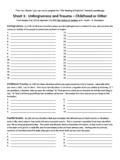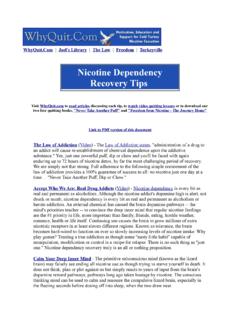Transcription of Into Thin Air - Whalen English
1 1 into thin AirInto thin AirInto thin AirInto thin Air by Jon Krakauer I stood atop Mount Everest, gasping for air at the topmost limit of earth s atmosphere. Standing on the top of the world, I cleared the ice from my oxygen mask, put my shoulder against the wind, and stared at the vast view of earth below. I understood on some dim level that it was a spectacular sight. I'd been dreaming about this moment for many months. But now that I was finally here, standing on the summit of Mount Everest, I just didn t have the energy to care.
2 It was the afternoon of May 10, 1996. I hadn't slept in 57 hours. The only food I'd been able to force down over the last three days was a bowl of soup and a handful of peanut M&M's. Weeks of violent coughing had left me with two separated ribs, making it painful to breathe. Twenty-nine thousand twenty-eight feet up in the atmosphere, there was so little oxygen reaching my brain that my mental capacity was that of a child. I was incapable of feeling much of anything except cold and tired. I'd arrived on the summit a few minutes after Anatoli Borkreev, a Russian guide with an American expedition, and just ahead of Andy Harris, a guide with the New Zealand-based mountain climbing team that I was a part of.
3 I snapped four quick photos of Harris and Boukreev and then turned and started down. My watch read 1:17 All told, I'd spent less than five minutes on the roof of the world. 2 After a few steps, I paused to take another photo, this one looking down the Southeast Ridge, the route we had climbed. Then I saw something that until that moment had escaped my attention. To the south, where the sky had been perfectly clear just an hour earlier, a blanket of clouds now hid the peaks of the other smaller mountains surrounding Mount Everest.
4 Days later after six bodies had been found, and after surgeons had amputated the right hand of my teammate Beck Weathers people would ask why, if the weather had begun to get worse, had climbers on the upper mountain not seen the signs of coming disaster? Why did experienced Himalayan guides keep moving upward, leading a group of amateurs, each of whom had paid as much as $65,000 to be taken safely up Everest, into an apparent death trap? I couldn t think about these things now. I needed to get down fast. It was after 2:30 PM when I made it down to the South Summit.
5 By now, mist was wrapping across the top of Mount Everest s sister peak, 27,000-foot Lhotse, and fog was lapping at the lower part of Everest's summit pyramid. No longer did the weather look so good. I grabbed a fresh oxygen cylinder and hurried down into the cloud. Moments after I dropped below the South Summit, it began to snow lightly and the visibility went to hell. Four hundred feet above, where the summit was still washed in bright sunlight under a blue sky, my compadres were wasting time, celebrating their arrival at the top of the 3 planet with photos and high-fives, all the while using up precious ticks of the clock.
6 None of them imagined that a horrible ordeal was drawing near. None of them suspected that by the end of that long day, every minute would matter. How had these minimally qualified climbers gotten themselves into this mess? As a matter of fact, how had I? _____ Secretly, I had dreamed of climbing Everest from childhood, and as the years went by, it began to seem that this impossible dream might come true. By the early 1980s, Everest's easiest route the Southeast Ridge, had been climbed more than a hundred times. Then, in 1985, the gates were flung wide open when Dick Bass, a wealthy 55-year-old Texan with limited climbing experience, was taken to the top of Everest by an extraordinary young climber named David Breashears.
7 In climbing Everest, Bass became the first person to ascend all of the so-called Seven Summits, a feat that earned him worldwide renown and spurred a swarm of other amateur climbers to think about Everest. Bass showed that Everest was within the realm of possibility for regular guys. Assuming you're reasonably fit and have a good income, I think the biggest obstacle is probably taking time off from your job and leaving your family for two months, Bass said. For a great many climbers, the record shows, stealing time away from the daily grind has not been an insurmountable obstacle; nor has the big outlay of cash.
8 Over the past 4 half-decade, the traffic on Everest, has grown at an astonishing rate. And to meet demand, the number of commercial enterprises offering guided ascents of these mountains has multiplied. In the spring of 1996, 30 separate expeditions were on the slopes of Everest, at least eight of them organized as moneymaking companies. The increase in commercial expeditions was a touchy issue. Traditionalists were offended that the world's highest summit was being sold to rich amateurs who, if denied the services of guides, would have difficulty making it to the top of Mount Shasta.
9 The critics were the real climbers -- opposed to amateur climbers and the businesses that dragged these amateurs to the top of a peak they could never reach on their own. Such critics also point out that, thanks to the commercialization of Everest, the peak has now even been dragged into the swamp of American law. Having paid great sums of money to be escorted up Everest, some climbers have then sued their guides after they failed to reach the summit. "Occasionally you'll get a client who thinks he's bought a guaranteed ticket to the summit," complains Peter Athans, a highly respected guide who's made eleven trips to Everest and reached the top four times.
10 "Some people don't understand that an Everest expedition can't be run like a commuter train. We can t guarantee that a customer will get to the summit. These lawsuits are unfair. For the most part, Athans is right. But not every Everest lawsuit is unfair. Inept or disreputable companies have on more than one occasion failed to deliver to climbers crucial support - oxygen, for instance - as promised. On some expeditions, guides have 5 gone to the summit without any of their clients, leading the bitter clients to conclude that they were brought along simply to pick up the tab for ambitious professional climbers who otherwise could not afford an Everest expedition.








